Bullet journaling: how to manage your stress

Many people pledge to become better versions of themselves for the new year. While these New Year’s resolutions can take an endless number of forms, a lot of these promises fall along the lines of being more organized and procrastinating less. Journaling has seen a huge rise in popularity over the past several years — this versatile hobby can be used as a way to stay on top of the countless tasks that plague lives as the year progresses.
Of course, there are other reasons to journal besides just arranging your life. Many individuals use it as a way to relax, which is most apparent when using journaling to make the items on a growing to-do list manageable. Journaling can also help you take a break from technology in general, even if it’s just for a few minutes a day. Screens invade our daily lives almost nonstop, and most activities are digitized in some way or another. Actually putting a pencil or pen to paper allows the user to separate themselves from often stress-inducing devices.
Even better, journaling is a relatively easy hobby to adopt because there are almost no rules or restrictions. To get started, all you need is some type of notebook and a pen or pencil. Pens are better because they stand out more on white paper, but it is also important to make sure the ink doesn’t bleed onto multiple pages underneath. Using a set of pens in different colors alllows for more variety in the notebook’s contents. Notebooks that are grid-lined or unlined are best because they allow more freedom when making doodles or designs. Additionally, some use supplies such as a ruler (for making tables, graphs and calendars), washi tape (decorative tape) and stickers (for personalizing your notebook).
While some decide to adopt their own journaling style, the style most often used is bullet journaling. To start a bullet journal, designate the first page as a table of contents. On the next page, draw 12 miniature calendars for all 12 months of the year, numbering each day and indicating days of the week. Continue the journal in the following pages by creating more calendars. The calendar for a single month should take up an entire page and the following page should be a calendar of a single week within that month. Each weekly calendar should be followed by daily to-do lists that take up one page (resulting in seven to-do lists following a one-week calendar). It’s recommended that you create a key for the activities and action items you put in your calendars and place it at the beginning of your journal to indicate completed tasks, canceled events and very important to-do list items.
That being said, bullet journals don’t have to be restricted to tracking classes and assignments. Many choose to track their mood, diet, exercise or sleep over the course of a week or month to learn more about themselves and find ways to refine their life.
Journaling may seem like just another task to be added to the growing list of activities and responsibilities that can accompany the new year. The purpose of journaling isn’t to add more stress to a busy life; it’s to provide more control to the journaler so that they are empowered to accomplish everything they need to for the coming days, weeks and months. Even if your journal fails to follow the somewhat-rigid structure of a classic bullet journal, your efforts will still bring you closer to your New Year’s goal.
More from The Rice Thresher

Acting like an athlete: Rice basketball alum takes on Broadway
Underneath Chadd Alexander’s Broadway costume, there’s ankle tape and wrist braces — same protective gear he wore as a walk-on basketball player at Rice, though now he’s performing eight shows a week in the ensemble of “Harry Potter and the Cursed Child” instead of running conditioning drills in Tudor Fieldhouse.
“Love Island” Season 7: A Messy, Magnetic Reality Show
It was my first time watching “Love Island,” and I get it now. There's a cycle to this show: you swear you won't get sucked in, you dismiss it as background noise, and then, one week later, you're canceling plans just to hear a group of twenty-somethings debate the meaning of the word "exploring." The truth is, “Love Island” has plenty of flaws. It’s too long, too produced and too ridiculous, but I'll be the first to admit it: I'm already planning to watch next season.
Review: “F1: The Movie” puts pedal to the metal
Joseph Kosinski, Claudio Miranda and Jerry Bruckheimer — the trio behind “Top Gun: Maverick” — return to high-octane spectacle with “F1,” a sports drama that blends spectacle with surprising humanity. It’s loud, stylish and frequently overwhelming, but it’s also one of the most engaging racing movies in years.


Please note All comments are eligible for publication by The Rice Thresher.